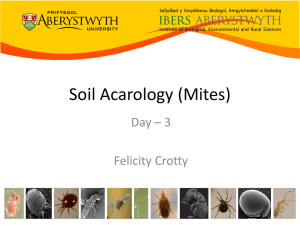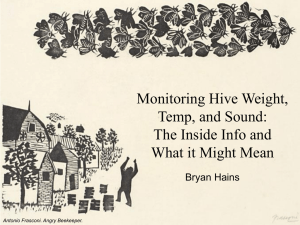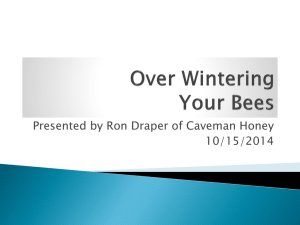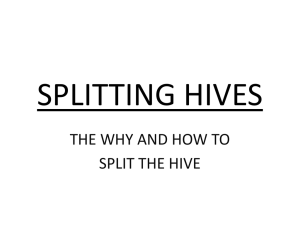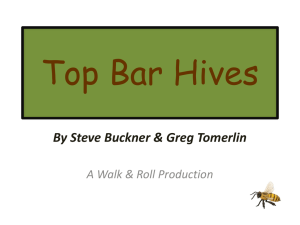Pests and Predators by Ellen Miller
advertisement
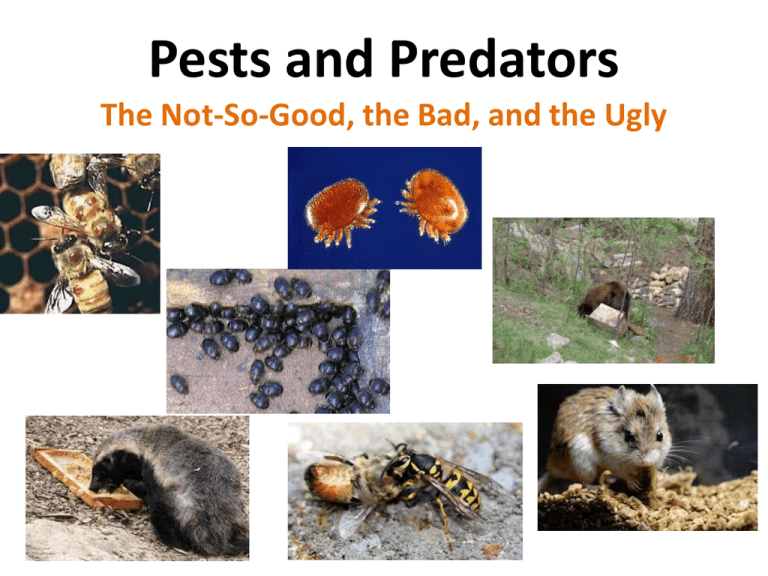
Pests and Predators The Not-So-Good, the Bad, and the Ugly Predators and Pests What We Will Cover • • • • • • • • Mites: Tracheal and Varroa Small Hive Beetle Wax Moths Ants, Spiders, Earwigs Wasps, Hornets, Yellow Jackets Mice Skunks, Raccoons, Badgers, Bears Domestic Livestock and Not-So-Domestic Predators and Pests • Mites: Began to be a significant problem in the mid 1980’s with 50%-80% losses in the North East in 1995. – Tracheal mites (Acampis woodi) • Microscopic in size, numerous enough to impede respiration • See bees crawling on ground in front of hive • Biggest problem in Fall decreasing the life span of the Winter bee • Treatment: Menthol and formic acid (Mite-Away II) – temperature dependant (50-79 degrees); most effective 60-75 degrees – can’t use when honey supers are on – grease patties may stop the transfer of mites from one bee to another (6c sugar mixed with 3 c hydrogenated vegetable shortening – Crisco) divided into 10 patties, 1 per hive Mites cont. Varroa mites (Varroa destructor): Originally found on the eastern hive bee of Asia which had adapted to the mite and enjoyed a host/parasite relationship. Transferred to the honey bee which did not have a defense to this parasite resulting in killing majority of feral hives in US • • • Oval reddish brown mite lives on the outside of the adult bee and larva and are visible Detection: Mite board inserted under the screened bottom board or ether roll technique Treatment: – Apistan; Mite-Away II; Sucrocide; Apiguard; Api Life Var; Hivastan; Check Mite (illegal to harvest honey) Mites have developed resistance to Apistan – Soft chemicals such as Formic Acid, Thymol, Sucrose octanoate can be sprayed on bees; treats tracheal mites; Eucalyptus essential oil – Integrated Pest Management (IPM): Natural method • Drone comb • Screened bottom boards • Split (no brood) Predators and Pests cont. • Small Hive Beetle (Aethina tumida) • Discovered in southern US in 1996. • Adult has six legs, two pair of wings, reddish brown/black, ¼” long; feed off of pollen on solid bottom boards • Larvae are cream; 1/16”; when mature they burrow into the ground under the hive • Treatment: Usually not necessary in this state Relocate hive Freezing temps Predators and Pests cont. • Wax Moths -- Don’t attack bees directly – Larvae feed on combs (pollen, brood) – Healthy hive will take care of them – Abandoned or improperly stored frames Predators and Pests cont. • Ants – Placement of hive away from established nest – Vaseline, ashes, diatomaceous earth, cinnamon • Spiders – Ghost spider predates on field bees • Earwigs Predators and Pests cont. • Wasps, Hornets, Yellow Jackets – Will take over a weak hive – Trap queens in early spring (March) – Can fly in colder temperature – Hang traps near hive Predators and Pests cont. Mice – restrict opening Skunks and Raccoons – keep hive off ground, secure hive bodies Badgers – secure hive bodies Bears – 7’ tall heavy duty electrified fence Predators and Pests cont. Domestic livestock – Poultry – Cows, Horses, etc. Not domesticated! Predators and Pests The Not-So-Good, the Bad, and the Ugly Summary Pests and Predators In-hive Out-of-hive Treatment and/or deterrent IPM – Integrated Pest Management Healthy, strong hives




